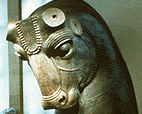 "One of the world’s great collections of antiquities from ancient Iraq will be on display at the University’s Oriental Institute, beginning Saturday, Oct. 18. The Edgar and Deborah Jannotta Mesopotamian Gallery, remodeled as part of an ongoing renovation project, will open with an exhibition devoted to the Oriental Institute Museum’s Mesopotamian collection. "
"One of the world’s great collections of antiquities from ancient Iraq will be on display at the University’s Oriental Institute, beginning Saturday, Oct. 18. The Edgar and Deborah Jannotta Mesopotamian Gallery, remodeled as part of an ongoing renovation project, will open with an exhibition devoted to the Oriental Institute Museum’s Mesopotamian collection. "
“The gallery documents the powerful sweep of the rise and growth of civilization in the region—from its foundations in prehistoric times, through the glories of the city-states at the time of Ur, to the great empires of Babylonia and Assyria, and on into the 7th century A.D.,” said Karen Wilson, Director of the Oriental Institute Museum.
At the far end of the gallery, opposite the visitor’s center, is the most spectacular object in the Mesopotamian collection—a human-headed winged bull that stands 16 feet tall. The statue, known by many Chicagoans as the “Assyrian Bull,” is one of the museum’s most popular items and gains splendor in a new setting that calls attention to its original architectural purpose.
Six 10-foot stone reliefs from the throne-room facade in the palace of the Assyrian king Sargon II (who ruled from 721 to 705 B.C.), flank the bull statue. Oriental Institute archaeologists excavated the bull and the reliefs at Sargon II’s capital city Dur-Sharrukin, known today as Khorsabad. This stunning new installation, the Yelda Khorsabad Court, which is the result of more than 10 years of work, evokes the feeling of grandeur and power of the palaces and temples of the mighty Assyrian Empire.
I can attest to the breathtaking nature of the bull statue as I was fortunate enough to see it on a visit to the museum several years ago where I also attended the "Treasures From The Royal Tombs of Ur" exhibit.
No comments:
Post a Comment